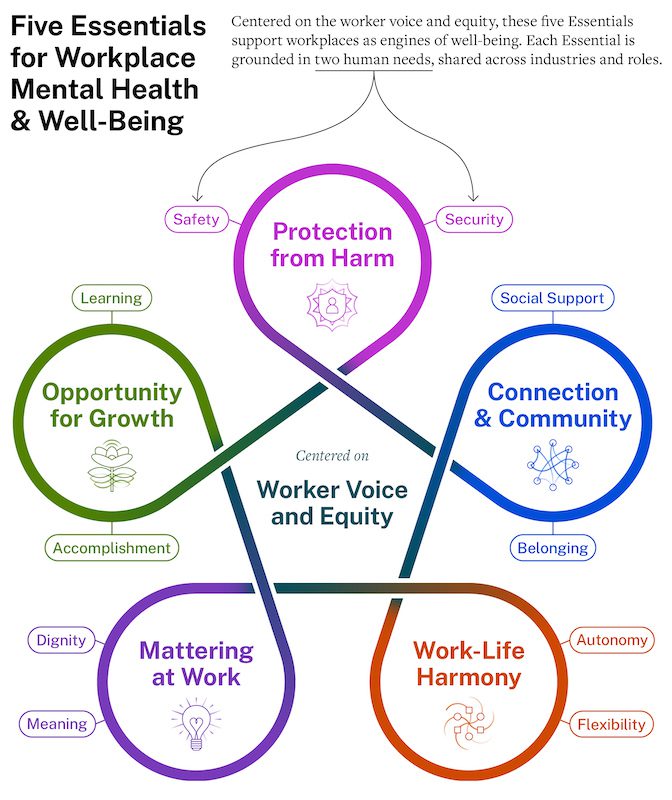A new report from the US Surgeon General warns that the American workplace needs an overhaul to address the emotional and physical well-being of employees. And it provides a road map on how to do it.
If the last two years have proved anything, it’s that the American Worker is a force of nature, incredibly adaptive to whatever is thrown at us. The pandemic also put the world on notice that business as usual isn’t going to cut it any longer, especially after the innumerable pivots made by everyone from large corporations to solo entrepreneurs during the months that followed.
Even our very vocabulary changed, and acronyms and terms like WFH, videoconferencing and flex schedules are now the new normal and the way forward. The takeaway is that the days of the same routine, punching-in from 9 to 5, Monday through Friday, are in the rearview mirror not only for millions of workers here, but also worldwide.
But along with these disruptive shifts come inherent stressors and challenges as we perform additional tasks, learn new technologies, and go from large offices with defined teams and duties to remote-work hubs, fluid collaborations, short-term projects and individual endeavors. And that doesn’t even take into consideration what we deal with in our private lives, including everything from parenting and personal finances to housing and health issues.

To help businesses of all sizes navigate this new world — while ensuring all stakeholders from CEOs to frontline workers have the opportunity to work in optimum conditions — the US Surgeon General, Dr. Vivek H. Murthy, released a new report with actionable guidelines entitled Workplace Mental Health and Well-Being.
The 46-page downloadable report is paired with an interactive website that acknowledges how the pandemic brought the relationship between work and well-being into clearer focus. To underscore this point, the site utilizes some striking statistics, including one showing that 84 percent of one study’s respondents said the conditions of their workplace had contributed to at least one mental health condition.
“Workplace mental health and well-being is a critical priority for public health. It has numerous and cascading impacts for the health of individual workers and their families, organizational productivity, the bottom-line for businesses, and the U.S. economy,” states the report.

While government websites aren’t always known for being user-friendly, the report’s companion site features a clear and concise design and flow that allows for a top-line skim of a recommended five-part framework called the Five Essentials. Here you can review major findings while also having the option to do a deeper dive with links to related resources.
For a preview of what each of the Five Essentials cover and the solutions they offer, here’s your THRIVE cheat sheet — though we do encourage you to visit the full website, as there are some great insights.
The Surgeon General’s Framework for Workplace Mental Health and Well-Being

Essential 1: Protection From Harm
Overview: The first Essential of this Framework is Protection from Harm. Creating the conditions for physical and psychological safety is a critical foundation for ensuring workplace mental health and well-being. This Essential rests on two human needs: safety and security.
Essential 2: Connection and Community
Overview: The second Essential of the Framework is Connection and Community. Fostering positive social interactions and relationships in the workplace supports worker well-being. This Essential rests on two human needs: social support and belonging.
Essential 3: Work/Life Harmony
Overview: The third Essential of this Framework is Work/Life Harmony. Professional and personal roles can together create work and non-work conflicts. The ability to integrate work and non-work demands, for all workers, rests on the human needs of autonomy and flexibility.

Essential 4: Mattering at Work
Overview: The fourth Essential of the Framework is Mattering at Work. People want to know they matter to those around them and that their work matters. Knowing you matter has been shown to lower stress, while feeling like you do not can raise the risk for depression. This Essential rests on the human needs of dignity and meaning.
Essential 5: Opportunity for Growth
Overview: The final Essential of this Framework is Opportunity for Growth. When organizations create more opportunities for workers to accomplish goals based on their skills and growth, workers become more optimistic about their abilities and more enthusiastic about contributing to the organization. This Essential rests on the human needs of learning and a sense of accomplishment.
“It turns out that when we invest in the mental health and well-being of our workers, two things happen,” says Murthy in a recent PBS NewsHour interview. “Our workers are better off, but, also, the organizations are better off. Their productivity, their retention, creativity in the workforce all go up. So it’s a win-win to focus on mental health in the workplace.”




